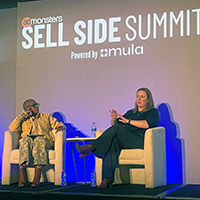THERE IS A legend among circulation directors about a renewal pitch done by Mad magazine back in its heyday.
Although Mad did not try to acquire subscribers, let alone renewals, someone decided to find out whether the magazine had any subscribers in Haiti. And Mad did. Exactly one subscriber.
Soon after landing in Port-au-Prince on a staff junket, “the usual bunch of idiots” loaded themselves into a rented bus and drove out to see their one lone subscriber. When they got to his house, they handed him a renewal blank.
While the actual response rate to this early one-to-one marketing campaign is unknown, the result is easy to guess. It’s little wonder that most circulation directors favor less dramatic and innovative approaches as they fight to maintain their rate bases.
For typical circulators, that means a mix of direct mail, a special wrap on the magazine, and outbound telemarketing.
Bloomingberg Personal Finance, a monthly magazine featuring investment news and advice, relies on a seven-effort renewal series, which starts six months – five issues – before the expire date and continues one month beyond expiration, according to Matthew Goldengerg, operations director for the magazine.
The first three efforts are direct mail packages. The package is a short form piece made up of a small letter and a one-piece reply envelope. The invoice snaps off the letter.
The pitch explains that renewing now means the subscriber can avoid renewing at a higher price later. Goldenberg describes the savings for early renewals as 15% to 20% less than subsequent offers.
The fourth and fifth efforts are cover wraps stating that the issue is the next to last or last issue respectively.
“The wraps work well,” Goldenberg says. “They’re holding a potent reminder.”
The sixth effort is a postcard, while the seventh effort is an outbound telemarketing pitch. Goldenberg adds that Bloomberg Personal plans to test using telemarketing as the sixth effort and postcards as the seventh.
Bloomberg Personal earns from 66% to 75% of its renewals with the first effort and picks up another 10% with the second effort. Response rates drop after the first two efforts. According to Goldenberg, the total number of renewals of Bloomberg Personal’s 215,000 subscribers “fluctuates substantially.”
The names of former subscribers are kept and are eventually recycled into new business campaigns. Goldenberg explains that the names aren’t “hit right away.” Instead, Bloomberg Personal waits at least a year before trying to get them to subscribe again.
“We find they perform better when compared to other direct marketing lists,” he says, adding that using such a list is more cost effective than any list he could rent. Goldenberg estimated the savings to be as much as 15%.
In addition to testing the sequence of the renewal effort, Goldenberg plans to test new copy, pulling tidbits from recent Bloomberg Personal articles. He feels that reminds subscribers of all the “great stuff” they read in the magazine.
The magazine also plans to test e-mail renewals in the spring.
Goldenberg has tested such premiums as coffee mugs and the like, but doesn’t like them. In addition to not being successful – as compared to price breaks – he feels that subscribers get hooked on the premiums rather than the magazine.
“Our selling point is that our readers want our magazine, not coffee mugs,” Goldenberg says.
Bloomberg Personal readers, Goldenberg explains, are “smart, sophisticated, and savvy about investing responsibly.” Demographically, they are affluent, educated, 85% to 90% male, fiftysomething, and live in metropolitan areas or affluent suburbs.
The Advocate, a national gay and lesbian biweekly news magazine, outsources its circulation to Triangle Marketing, a New York-based list consultancy headed by its former circulation director John Knoebel.
Knoebel describes his campaigns as similar to what any circulation manager’s would be: seven notices to conversion; six notices to renewal.
However, renewals are always at full price. Conversion, Knoebel claims, is up to 50% the first time; 70% the second time; and 85% the third time and beyond. Of The Advocate’s 80,000 circulation, according to the ABC audit, almost 68,000 are subscribers.
The renewal campaign begins 14 issues prior to the last issue. The focus is on “multi-year terms with long-term savings,” as Knoebel puts it. As the campaign progresses, the number of years The Advocate offers dwindles down to one, which is “easier for the more reluctant.”
Expires are immediately recycled into the next acquisition campaign.
The magazine has tested two new approaches over the past year-for The Advocate, not necessarily new for magazine renewal campaigns in general.
For the first time, The Advocate offered a gift subscription. Some 12% took advantage of the gift offer to renew and give a subscription to a friend.
To renew the gift subscriptions, Knoebel plans to split the campaign. The first three pieces will go to the donor, while the recipient will get the final three notices. He expects them to be a “fairly receptive group.”
The other test was telemarketing for renewals. The Advocate had been reluctant to use telemarketing because of “privacy concerns,” even when phoning subscribers at home, Knoebel says.
The telemarketing was tested on 5,000 lapsed subscribers and garnered an 18% response rate.
“We had fewer complaints about telemarketing than normal,” Knoebel continues. “Even lapsed subscribers felt they had a bond with The Advocate.”
However, e-mail renewals are still relegated to “probably not.” Knoebel cites what he calls “the spamming issue.” The Advocate’s site itself (www.advocate.com) is being upgraded to accept credit cards for subscriptions, and visitors can sign on to receive weekly updates. The magazine, Knoebel explains, was initially reluctant to get involved with commercial or product offerings.
The Advocate’s readers are 70% male, around 40, and mostly urban. Knoebel says around 68% of The Advocate’s readers live in the top 100 cities in the United States.
P.O.V., a lifestyle magazine for twentysomething men, switched from outsourcing its circulation management to an in-house department of four people, managed by Richard Price. An in-house department, Price explains, allows greater speed, flexibility, and testing of new ideas.
According to Price, P.O.V. is an unusual publication for two reasons. First, as a young publication, barely two years old, it is really only just launching its first major renewal effort. The first major subscription effort was launched in the middle of 1997.
Second, some 95% of its 330,000 rate base is subscriptions. Newsstand distribution is difficult for independent titles, he explains.
Because there is no renewal history to draw upon, Price is in a testing mode for P.O.V. Tests include standard mailings, cover wraps on the last issue, and price breaks. As Price puts it, since P.O.V. is in an expansion mode, the cut rate is more than made up for the money saved in the cost of developing new business.
P.O.V. is focusing on multi-year renewals as well as renew at full price and give a gift subscription at half price offers.
The full series starts four months prior to expiration. Six mail pieces are followed by a cover wrap and a telemarketing calls two months a week after the last issue. P.O.V. doesn’t “grace” issues, Price explains.
The first efforts earns between a 15% to 20% response rate and the rest trickle in. He adds that the second best results are from the second mailing and the third best is from the wrap.
Subscribers can also renew using P.O.V.’s toll free number or its Web site (www.povmag.com). While the site does capture e-mail addresses with orders, the numbers aren’t there for e-mail renewal campaigns, Price explains.
He does plan to look more into e-mail renewals next year. He assumes that if P.O.V. has the address, then have a business relationship (and hence the pitch isn’t spam). P.O.V. does execute e-mail promotions and Price describes the list as “opt-in.”
Price also spurns using premiums with renewals. Such use, he explains, has to be reported in the ABC audit. He feels a readership developed with premiums is of diminished value to advertisers. However, premiums based on P.O.V. editorial content to acquire subscribers have been used.
Despite being the ultimate young guy’s magazine, over 10% of its readers are female, Price claims. Women, he explains, like the how to get ahead in business coverage.
P.O.V.’s target, however, is the “emerging affluent male,” just out of college, but not yet married, with an average household income that Price estimates at $70,000.
Efforts that are all worth while, because, as Goldenberg says, “Renewals are more important over time.”



